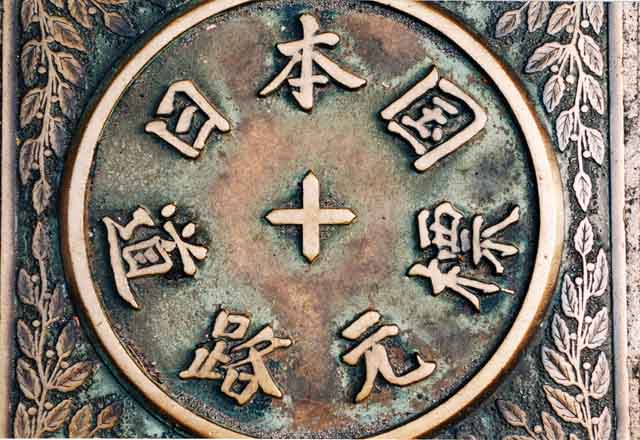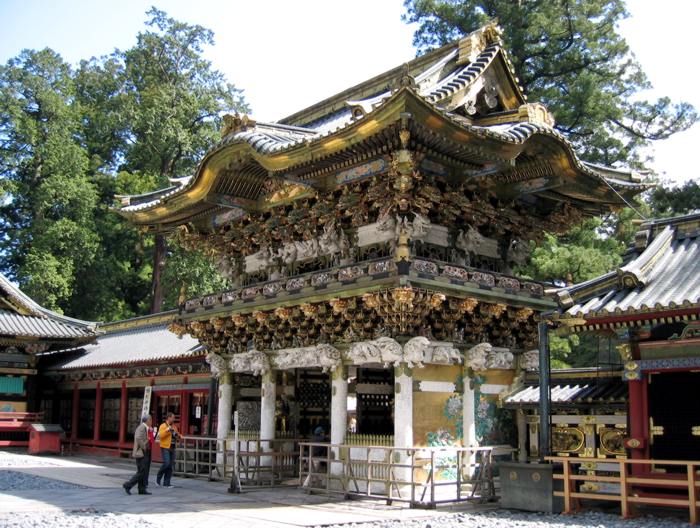NikkŇć KaidŇć on:
[Wikipedia]
[Google]
[Amazon]
 The was one of the centrally administered five routes of the
The was one of the centrally administered five routes of the
. Accessed August 15, 2007. With only twenty-one stations, the NikkŇć KaidŇć was the shortest of the five routes, and it shares seventeen stations with the ŇĆshŇę KaidŇć. Its route can be traced with Japan's National Route 4 and National Route 119.
 :Starting Location:
:Starting Location:
 :14. Koganei-shuku (ŚįŹťáĎšļēŚģŅ) ( Shimotsuke)
:15. Ishibashi-shuku (Áü≥ś©čŚģŅ) (Shimotsuke)
:16. Suzumenomiya-shuku (ťõÄŚģģŚģŅ) (
:14. Koganei-shuku (ŚįŹťáĎšļēŚģŅ) ( Shimotsuke)
:15. Ishibashi-shuku (Áü≥ś©čŚģŅ) (Shimotsuke)
:16. Suzumenomiya-shuku (ťõÄŚģģŚģŅ) (
 The was one of the centrally administered five routes of the
The was one of the centrally administered five routes of the Edo period
The , also known as the , is the period between 1600 or 1603 and 1868 in the history of Japan, when the country was under the rule of the Tokugawa shogunate and some 300 regional ''daimyo'', or feudal lords. Emerging from the chaos of the Sengok ...
. It was built to connect the ''de facto'' capital of Japan at Edo (modern-day Tokyo
Tokyo, officially the Tokyo Metropolis, is the capital of Japan, capital and List of cities in Japan, most populous city in Japan. With a population of over 14 million in the city proper in 2023, it is List of largest cities, one of the most ...
) with the temple-shrine complex of the Mangan-ji and TŇćshŇćsha (now called the RinnŇć-ji
is a Tendai Buddhist temple in the city of NikkŇć, Tochigi, NikkŇć, Tochigi Prefecture, Japan.
History
The site was established in 766 by the Buddhist monk ShŇćdŇć ShŇćnin (735‚Äď817). Due to its geographic isolation, deep in the mountai ...
and TŇćshŇćgŇę), which are located in the present-day city of NikkŇć
is a Cities of Japan, city in Tochigi Prefecture, Japan. , the city's population was 80,239, in 36,531 households. The population density was 55 persons per km2. The total area of the city is .
NikkŇć is a popular destination for Japanese and ...
, Tochigi Prefecture
is a landlocked Prefectures of Japan, prefecture of Japan located in the KantŇć region of Honshu. Tochigi Prefecture has a population of 1,897,649 (1 June 2023) and has a geographic area of 6,408 Square kilometre, km2 (2,474 Square mile, sq mi ...
, Japan. It was an ancient path that became formalised when power moved to Edo, and was established fully in 1617 by Tokugawa Hidetada, to give safer access to the temple-shrine mausoleum of his father, the first shogun Tokugawa Ieyasu, who was buried there that year.NikkŇćdŇć. Accessed August 15, 2007. With only twenty-one stations, the NikkŇć KaidŇć was the shortest of the five routes, and it shares seventeen stations with the ŇĆshŇę KaidŇć. Its route can be traced with Japan's National Route 4 and National Route 119.
Stations of the NikkŇć KaidŇć
The 21 stations of the NikkŇć KaidŇć are listed below in order and are divided by their modern-day prefecture. The present day municipality is listed afterwards in parentheses.Tokyo
 :Starting Location:
:Starting Location: Nihonbashi
is a business district of ChŇęŇć, Tokyo, Japan, which sprung up around the bridge of the same name that has linked two sides of the Nihonbashi River at this site since the 17th century. The first wooden bridge was completed in 1603. The curre ...
(śó•śú¨ś©č) ( ChŇęŇć-ku)
:1. Senju-shuku (ŚćɚŏŚģŅ) ( Adachi-ku) (also part of the Mito KaidŇć)
Saitama Prefecture
:2. SŇćka-shuku (ŤćȌ䆌ģŅ) (SŇćka
is a Cities of Japan, city in Saitama Prefecture, Japan. , the city had an estimated population of 249,645 in 118,129 households and a population density of 9100 persons per km². The total area of the city is .
Geography
SŇćka is situated in ...
)
:3. Koshigaya-shuku (Ť∂ä„É∂Ťį∑ŚģŅ) ( Koshigaya)
:4. Kasukabe-shuku (Á≤ēŚ£ĀŚģŅ) ( Kasukabe)
:5. Sugito-shuku (śĚČśąłŚģŅ) ( Sugito, Kitakatsushika District)
:6. Satte-shuku (ŚĻłśČčŚģŅ) ( Satte)
:7. Kurihashi-shuku (ś†óś©čŚģŅ) ( Kuki)
Ibaraki Prefecture
:8. Nakada-shuku (šł≠ÁĒįŚģŅ) ( Koga) :9. Koga-shuku (ŚŹ§ś≤≥ŚģŅ) (Koga)Tochigi Prefecture
:10. Nogi-shuku (ťáéśú®ŚģŅ) ( Nogi, Shimotsuga District) :11. Mamada-shuku (ťĖď„ÄÖÁĒįŚģŅ) ( Oyama) :12. Oyama-shuku (ŚįŹŚĪĪŚģŅ) (Oyama) :13. Shinden-shuku (śĖįÁĒįŚģŅ) (Oyama) :14. Koganei-shuku (ŚįŹťáĎšļēŚģŅ) ( Shimotsuke)
:15. Ishibashi-shuku (Áü≥ś©čŚģŅ) (Shimotsuke)
:16. Suzumenomiya-shuku (ťõÄŚģģŚģŅ) (
:14. Koganei-shuku (ŚįŹťáĎšļēŚģŅ) ( Shimotsuke)
:15. Ishibashi-shuku (Áü≥ś©čŚģŅ) (Shimotsuke)
:16. Suzumenomiya-shuku (ťõÄŚģģŚģŅ) (Utsunomiya
is the capital and largest city of Tochigi Prefecture in the northern KantŇć region of Japan. , the city had an estimated population of 513,584, and a population density of . The total area of the city is . Utsunomiya is famous for its ''gyoza'' ...
)
:17. Utsunomiya-shuku (ŚģáťÉĹŚģģŚģŅ) (Utsunomiya)
:18. TokujirŇć-shuku (Śĺ≥ś¨°ťÉéŚģŅ) (Utsunomiya)
:19. ŇĆzawa-shuku (Ś§ßś≤ĘŚģŅ) (NikkŇć
is a Cities of Japan, city in Tochigi Prefecture, Japan. , the city's population was 80,239, in 36,531 households. The population density was 55 persons per km2. The total area of the city is .
NikkŇć is a popular destination for Japanese and ...
)
:20. Imaichi-shuku (šĽäŚłāŚģŅ) (NikkŇć) (also part of the NikkŇć Reiheishi KaidŇć)
:21. Hatsuishi-shuku (ťČĘÁü≥ŚģŅ) (NikkŇć)
:Ending Location: NikkŇć ShinkyŇć (bridge) (śó•ŚÖČÁ•ěś©č) (NikkŇć)
See also
* Edo Five Routes ** TŇćkaidŇć (or53 Stations of the TŇćkaidŇć
The are the rest areas along the TŇćkaidŇć (road), TŇćkaidŇć, which was a coastal route that ran from Nihonbashi in Edo (modern-day Tokyo) to SanjŇć ŇĆhashi in Kyoto.. There were originally 53 government shukuba, post stations along the TÔŅĹ ...
)
**NakasendŇć
The , also called the ,Richard Lane, ''Images from the Floating World'' (1978) Chartwell, Secaucus ; pg. 285 was one of the centrally administered Edo Five Routes, five routes of the Edo period, and one of the two that connected the ''de facto'' ...
(or 69 Stations of the NakasendŇć)
** KŇćshŇę KaidŇć
** ŇĆshŇę KaidŇć
*Other Routes
** NikkŇć Onari KaidŇć
** NikkŇć Reiheishi KaidŇć
** NikkŇć WakiŇćkan
References
{{DEFAULTSORT:Nikko Kaido Road transport in Japan 1610s establishments in Japan